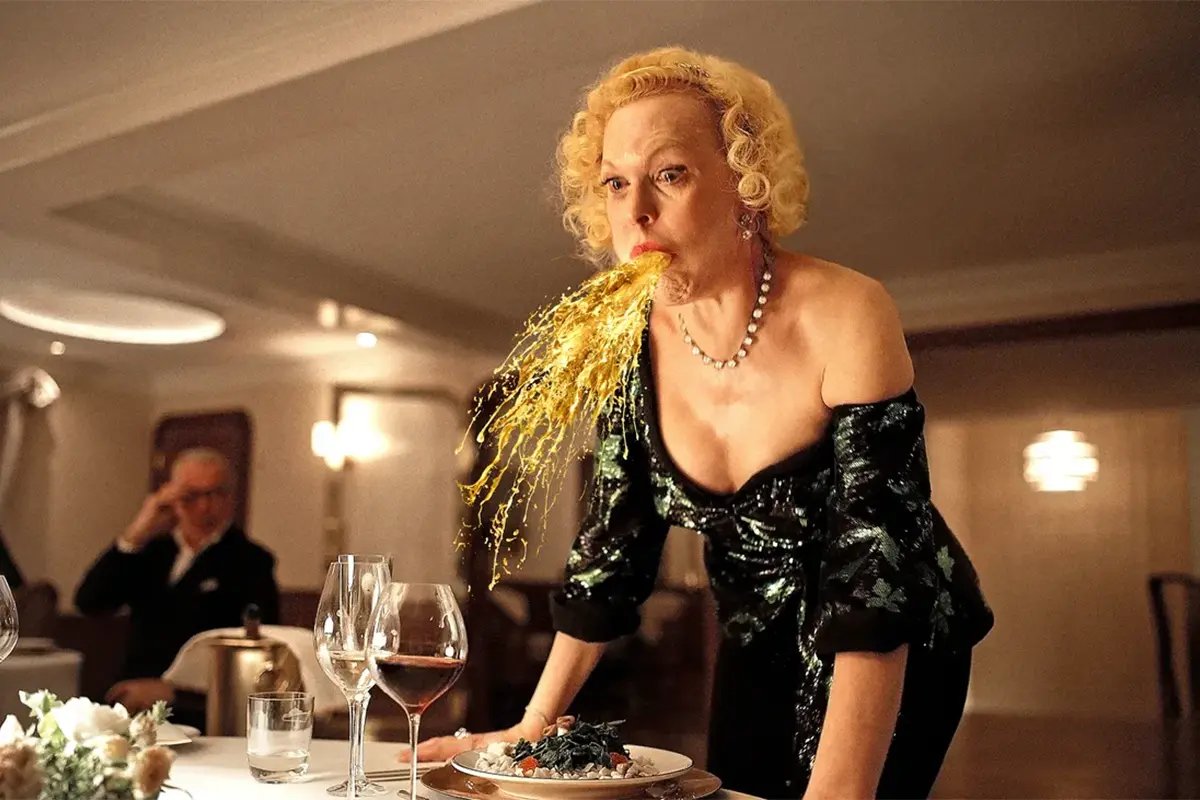Situated in a world of greed, elitism and prestige, Hollywood throws out one hilarious satire after another, critiquing the mega rich and their tone-deaf struggles. The ‘Eat the Rich’ obsession
Against wealth – White Lotus, Succession, Triangle of Sadness, the Menu
In recent years there has been a resurgence of class-related and politically driven cinema that all fit under the umbrella theme of ‘Eat the Rich’. Hollywood has been bombarding our screens with films and tv shows that although on the surface, are filled with wit and humor, all possess much deeper meaning. Mike White’s ‘White Lotus’, Jesse Armstrong’s ‘Succession’, Ruben Östlund’s ‘Triangle of Sadness’, or Mark Mylod’s ‘The Menu’, and countless others, have become part of a larger conversation: wealth.
Hollywood’s ‘Eat the Rich’ Obsession
Although it’s not the first time we see the theme of wealth portrayed on the screens of Hollywood, it seems as though the theme has become at the forefront of people’s minds, therefore becoming more prevalent across the entertainment industry. With the rise of billionaire tech companies and the infiltration of artificial intelligence, electric cars, and rockets being sent to outer space at faster rate than ever before, the conversation of wealth has grown exponentially. After all, the very foundation of film and art lies in political influences and expression of world views.
Due to the rise of social media over the last ten years, we have created a network that allows us to look in, and sometimes be a part of the lives of the one percent. Whether this be through reality tv, film, music, or podcasts, this connectedness has created an environment where the elite have become more than just a far away, untouchable concept. Instead, they have become something very real.
Hollywood’s Humor – Eat the Rich
Taboo topics, such as money, tend to come across better when a little bit of humor is involved. The way in which reality tv stars, actors, or musicians portray their lives on social media leaves a lot of their audiences skeptical of the way in which they chose to live their lives. Whether this skepticism is rooted in idolization or pure jealousy varies from person to person, but always seems to result in the same behavior: mockery.
This mockery of the rich and elite comes across in Hollywood’s recent films in different fonts. The very successful ‘White Lotus’ tv show directed by Mike White targets the strangeness that comes with wealth. The show follows three different groups of people on vacation at a luxury resort. As the show progresses, strange events start to occur one after another until we are left with an explosive ending. Mike White targets greed, obsession, and elitism with hilarious sarcasm and wit. We are left with sickening sensations of both empathy and guilt for each of the characters, allowing us to reflect on our own relationships to the modern concept of wealth, often associated with social media followings or political influence.
Hollywood ‘Eat the Rich’ – An obsession with influencing and aesthetics
With its critique on class, wealth, and society, Ruben Östlund’s ‘Triangle of Sadness’ takes us on a yachting experience filled with an elite crowd of influencers, weapon manufacturers, and big tech CEOs. Filled with vomit, shit, and tears, the film explores the concept of capitalism and social hierarchy in a stomach achingly hilarious manner.
Triangle of Sadness – Eat the Rich
The name ‘Triangle of Sadness’ has two clever meanings. Firstly, the ‘triangle of sadness’ is the real-world term for the area between the eyebrows and the very top of the nose bridge. This area tends to develop wrinkles with old age and emphasizes negative facial expressions, such as sadness or anger. This issue tends to be targeted using carefully placed Botox. The second meaning stems from the famous Bermuda triangle, where legend has it, many ships and planes have disappeared, never to be found again.
Although Botox, nor the Bermuda triangle make significant appearances in the film, they both possess symbolic connection with events occurring in the film.
Taking inspiration from the real-life fashion industry., the film toys with the concept of ‘sad faces’ for the more expensive brands, and ‘happy faces’ for the more affordable brands. The film introduces the harsh consequences that come from our social media obsession. We find ourselves in a time with more connection possible than ever before yet seem to be the most disconnected we’ve ever been.
When stranded on an island with no ability to connect with the world, our understanding of the capitalistic structure quickly melts away, leaving us with the harsh reality that we cannot in fact, eat money.

Eat the Rich: The Menu – the Horror of creative freedom
‘The Menu’ directed by Mark Mylod, is yet another film that stems from the same ‘eat the rich’ seed, playing on the needs and desires of the rich. Mark Mylod uses dark comedy to criticize the elite. Similarly to ‘Triangle of Sadness’ it is made apparent from the start of the film that the characters involved are extremely privileged and lacking perspective. The 2022 Thriller sees a group of ultra-rich folks invited to a lavish multi-course meal in a restaurant located on an isolated private island. When arriving on the island, the customers quickly find that there is much more waiting for them than just an exotic meal.
The film rapidly takes a cultish turn when Chef Slowik, the film’s protagonist, takes his frustration of cooking for clientele that never seem to be satisfied, out on this carefully chosen guest list at his new private restaurant. This ‘culinary cult’ if you will, takes inspiration from the elite cult world that exists in Hollywood.
Eat the Rich: the Succession’s Success
HBO’s Succession, created by Jesse Armstrong follows a group of incredibly wealthy, absorbed, distorted, and disconnected individuals. Jesse Armstrong has created an iconic family. The Roys consist of every type of bratty, snobby, and pretentious person you could think of. From the strong Lion figure, Logon, to Kendall Roy, the heir that just doesn’t seem to cut it, to Shiv Roy, the hardheaded narcissist, to the hilarious cocky brother, Roman Roy, to the eldest son Connor Roy, who’s position in the family is never made clear.
What makes Succession so gleamingly brilliant is its ability to convey so much in so few words. Jesse Armstrong’s carefully curated casting for the show resulted in a show so gripping you had no choice but to binge it every season. As the show progresses, themes of mental illness, hysteria, obsession and greed are explored in ways that allow us as the audience to find empathy in very unique ways for each of the characters.
The decades of abuse, trauma and neglect that sit in the backbone of these characters are intertwined and showcased in such graceful, yet chaotic ways. This constant battle between past, present and future is one that feels awfully familiar to us as human beings. But what happens when your future has already been written out and planned out for you?
Eat the Rich and the pity party
The goal of this resurgence of politically motivated and class related cinema seems to be for viewers to laugh at the disconnectedness of these rich beyond reason characters. We are made to feel as though we should scorn and pity these pretentious, lost souls whose meaning in life has become completely lost in material possessions and obscenely far-removed moral compasses. Whether this feels like a fair opinion or not, it’s hard to argue that Hollywood is in fact merely doing it’s job. Which is to observe, listen, and produce media accordingly.
The pandemic created an even larger gap and disparity between the world’s wealthiest and the world’s poorest. This increased separation has caused increased frustration. Watching us enter what looks like another recession, Hollywood producers are only thinking one thing: how do we keep selling? So, what better way to do this than to create films, and tv shows that target the very route of the frustration. Hence the production of ‘Eat the Rich’ films, allowing their audiences to let out a laugh, cry, and yell about all the wrongs that come with the mega rich.
Eat the Rich: Parasite and the power of prestige
The globally acclaimed and success of Bong Joon-ho’s Parasite released in 2019 can perhaps be deemed as the start of the resurgence. The large difference however, that exists between the masterpiece that is Parasite and the other films listed above is that unlike Parasite, these films have all been created and produced by the ‘elite’ the films are critiquing. Controversy exists in the fact that these films were created by people living within or adjacent to the socioeconomic sphere they are supposedly setting out to critique.
This may leave some audiences feeling confused and torn between the comedic digs that exists in all these films, and the reality that a lot of their politically motivated messages are being met with immense hypocrisy.
Eat the Rich
‘Eat the rich’ is a political slogan associated with anti-capitalism and left-wing politics. It may variously be used as a metaphor for class conflict, a demand for wealth redistribution, or a literal call to violence. The phrase is commonly attributed to political philosopher Jean-Jacques Rousseau, from a quote first popularized during the French Revolution: «When the people shall have nothing more to eat, they will eat the rich».



















